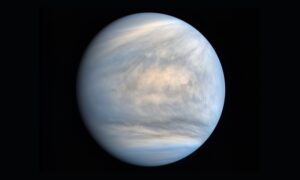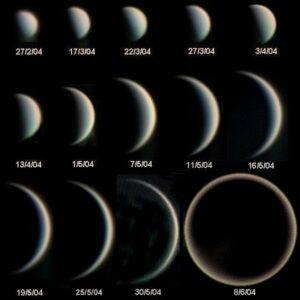*This post may contain affiliate links. This means we may make a commission if you purchase an item using one of our links*
If you’ve found yourself on this article, you’re probably wondering how you can see venus using a telescope. I’m into observing our local planets as much as any other guy into astronomy which is why I’ve put together this post for those that are struggling to locate Venus and guide them in the right direction.
Now to answer the question, the best way to see Venus is with a telescope that can magnify at least 50x, with a moon filter attached to the lens to reduce the brightness of Venus and when the sun is not directly in its background i.e 20 minutes before sunset or 20 minutes before sunrise.
This is because Venus is very bright, really close to the sun and is really close (relatively speaking) to our Earth, making it very tough to see the planet at night using a refractor or reflector device.
Of course that’s just the simple explanation of how you would go about observing Venus, throughout the rest of this post I will be going over most of what I mentioned in more detail so that you’ll be able to understand everything a little better.
What Is Venus?
Table of Contents

First I’ll briefly go over a bit of history on Venus in case you don’t know much about the planet. Venus is the planet you’ll find to be the second closest entity to the sun and as is to be expected, it’s very very hot.
In fact the planets surface is estimated to be around 864 degrees Fahrenheit (462 degrees Celsius) so yeah, it’s not something you can walk on without essentially melting.
Venus is roughly the size of Earth with a mass which is 82% that of Earth and a surface gravity which is 90% that of earth.
Venus is so bright that it’s regarded as the third brightest entity in our solar system behind the Sun of course and our Moon. Venus’ apparent magnitude can go as high as 4.9 and never dimmer than -3.0.
Venus is about 67 million miles from the Sun. Earth’s orbit averages about 93 million mile from the Sun. These numbers suggest that Venus’ year is 224.7 Earth days vs Earth’s year of 365 days. This means Earth and Venus can occasionally be very near each other whilst on other instances they can be 167 million miles apart.
In terms of the closest it can get to Earth, it’s estimated to be about 25 millions miles away.
As for how the Planets name came about, back in the era of the ancient Greeks and Roman empire, when mankind decided to document gazing beyond our skies, they noticed this very beautiful and striking entity, to them it was nothing short of breathtaking.
It gave off the aura of an effeminate beauty which is primarily why this planet was named Venus after the Greek goddess of love and beauty.
In fact many cultures, like the ancient Mayans, sumerians and pawnees all universally agreed that Venus’ appearance represented feminine beauty. The Mayans took a particular interest in the planet, so much so that they built an observatory simply to observe it.
That’s just a bit of history some basic synopsis on Venus, in the next parts of this article I will be going over how to observe Venus through your telescope.
Can You See Venus Without A Telescope?
In short yes you can, Venus as I said is actually the third brightest entity in our solar system so, at the right times it is more than possible to see it without a telescope.
The planet can either be seen low over the horizon towards the east before sunrise, or towards the west after sunset. Venus is often regarded as the “Evening Star” when it’s viewable from Earth so yeah, I guess you could say this Evening Star name goes to show how bright an entity Venus actually is.
When Is It The Best Time To View Venus?
The best time to view Venus is either 20 minutes before sunrise or sunset. The reason as to why is because firstly, Venus is an inner planet meaning it’ll always orbit faster around the sun than the earth therefore, in order to get a glimpse of the planet, you can only do so before sunrise and sunset.
In technical terms, the best time to observe Venus is when the planet is placed at just the right angle between the Earth and the Sun, which for Venus is 46 degrees. This is also known as the greatest elongation and is the ideal period for viewing the planet.
When this criteria is met, you’ll finally be able to see Venus, which is a period of time that should last for roughly 3 hours.
Venus is also only visible with ease at certain periods of time as it does orbit around the sun a lot faster than earth. This is why, generally speaking the best times to view it is from September till December, whilst it will be visible till around May.
However, when it is summer, it’ll be very hard to catch a glimpse of the planet.
What Equipment Do You Need To View Venus?
You can actually see venus with a pair of powerful binoculars and with some very small telescopes too. 60mm telescopes should be more than capable of seeing Venus if you have an eyepiece that allows for a 50x magnification. At this point Venus will be in view but, using a filter to dim the planet down is also something you’d need to consider purchasing.
As Venus is the third brightest entity in our solar system, if it were visible at all periods of the day and night, the planet would be easy to spot even in the day however, this isn’t the case. Nevertheless, a filter will be an important accessory to invest in.
Through my research I found that a 25% moon filter is what you should look to get so you can make out a lot more of Venus’ details. A moon filter, as the name would suggest, is a filter that’s designed to filter out the light of the moon when you look at it directly, so it acts more or less like sunglasses.
Lastly, you can also use an app to track Venus so that you can find it or if your system is computerised, you’ll be able put the information into the mounts database and it should point you towards Venus.
All in all, most system will be able to view Venus but, you will need an eyepiece that magnifies your device 50x+ for the best experience. If you’re looking into eyepieces, you can check this list I created discussing some of the better devices to pair with your telescope.
How Does Venus Look Through A Telescope?
Without a moon filter, the image you’d see through you’re telescope lens would be too bright to make out but, once you’ve attached a moon filter to the device, you should finally be able to make out its form.
Much like the moon, Venus can be seen in phases, from a crescent disk like shape to a full round view of it. At its brightest level, Venus will look like a crescent moon whilst it dims down the fuller its shape becomes.

The image above shows how the phases will look through your telescope lens, however, besides the phases, there isn’t much else to see. Venus doesn’t have its own moon so you can only observe the planet itself and as its covered in clouds you won’t be able to make out any other interesting details.
Nevertheless, I’m sure your very first time observing it and many sessions of observing the planet will always be a treat!
Summary
Venus itself is a beautiful entity, although slightly smaller, much hotter and practically featureless, it has for many centuries been regarded as beautiful. After all there is a reason why many ancient cultures, particularly the mayans really appreciated it.
Venus is a great planet to see for beginners getting into astronomy as it’s fairly easy to find, you can see it as it transitions through its phases and ultimately it’ll be fun for you to document.
If you’re thinking about getting into astronomy but don’t have your own telescope yet, I’d suggest checking this article we created to assist beginners in finding the right device for amateur astronomers but, as a whole I hope this article has helped you out a little when it comes to observing this beautiful aka Venus!

